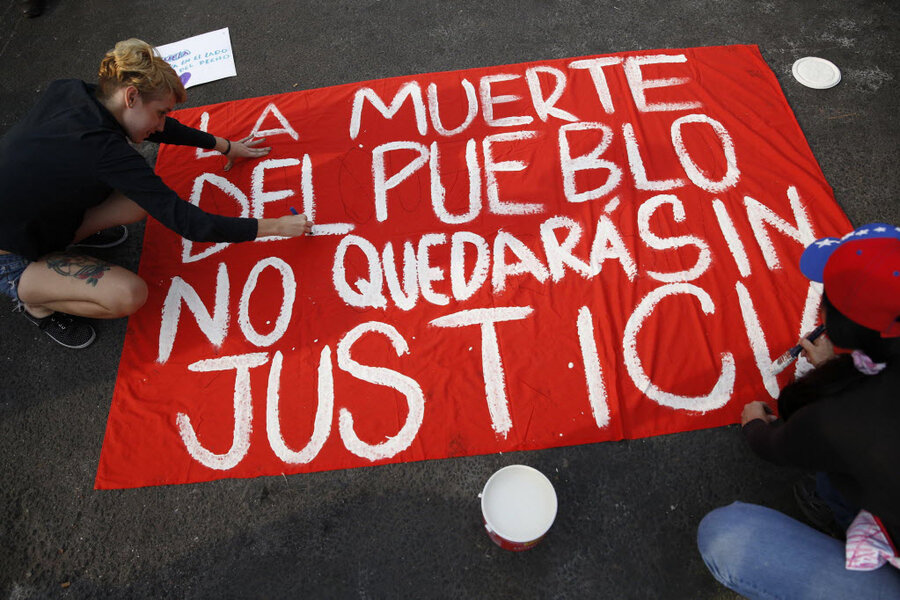Venezuela's 'angry gochos': Why protests continue in western Venezuela
Loading...
| San Cristóbal, Venezuela
Pitched battles between Venezuela’s security forces and antigovernment protesters in recent days have filled the streets of this western city with tear gas and tears.
Monday night a student was killed during the clashes as the government aimed to retake control of the city choked by protest barricades for more than a month.
But in a region of Venezuela long considered an opposition stronghold, and known for experiencing some of the worst food shortages in the nation, heavy-handed attempts to clear the streets have only served to strengthen the protesters resolve. "Every barricade they tear down, we will rebuild,” says Jose Vicente García, a student leader and city councilman.
Using heavy machinery and armored cars, the National Guard plowed through the barricades of old sofas and broken down refrigerators, bags of trash and barbed wire. They have dispersed the mostly student demonstrators with tear gas and rubber bullets, and some civilian pro-government militias have used live rounds.
Even as protesters mourn the death of Daniel Tinoco, who received a bullet wound to the chest Monday night, they began setting up new barricades at key intersections of the city today. “We will answer repression with more people on the streets,” Mr. García says.
People from Venezuela’s Andean region – including Táchira state, home to San Cristóbal – are referred to as gochos, once a disparaging label but now considered a term of endearment. Outside the region they are seen as calm and austere, but locals say what defines them are underriding currents of stubbornness and tenacity.
And since the protest began, the slogan, gochos arrechos, or angry gochos, has been a source of admiration from antigovernment Venezuelans across the nation. The history of this region, its geography, and its people come together to play a big part in why the protests began here, residents say. From the state’s location bordering Colombia to historic tales of citizens marching hundreds of miles to the Venezuelan capital to shake up the government, the “gocho way” also explains why few see the protests and clashes with government forces dying down anytime soon.
Politics vs. everyday life
Gochos traditionally tend to be politically conservative, and balked at late President Hugo Chávez's plan for “21st century socialism.” In last year's presidential elections, Táchira was one of eight states where opposition candidate Henrique Capriles beat out the hand-picked successor of the late Mr. Chavez, Nicolás Maduro, who won by just 1.5 percent of the vote nationwide. In December municipal elections, the opposition in San Cristóbal won 60 percent of the votes. Even when Chávez won overwhelming electoral victories in 2006, in Táchira he had just a 2.5-point margin, the narrowest in the country. By 2012, it was one of two states where Chávez lost.
But locals say the protests are more about everyday life than party politics. Venezuelans have been suffering from the shortage of basic goods for several years, and the central bank's scarcity index shows that 1 in 4 basic goods were out of stock at any given time across the country in January this year. But that situation has long been more acute in Táchira.
Located in the Venezuelan Andes, on the border with Colombia, Táchira has historically been more connected economically and culturally with its foreign neighbor to the west than with Caracas. And cross-border trade – both legal and illegal – is the lifeblood of the region.
Price controls on goods such as cooking oil, milk, and toilet paper, coupled with a weak currency, have increased the flow of goods across the border, hurting gochos further. In San Cristóbal, Oscar Guzmán, a bodyshop worker, got up at 4 a.m. recently to be second in line outside a supermarket that opens at 8 a.m. He was there to see if he could find corn flour, which is used to make traditional arepas, or corn cakes. Mr. Guzmán was in luck: the store had the special flour in stock, but with the shelves nearly bare, he was allowed to purchase only one kilo. In his family of five, this wouldn’t last for long, but he said he would take what he could get.
Meanwhile, across the Colombian border at the central market in Cucuta, stacks upon stacks of the very flour Guzman needed are unloaded from trucks. The bags were brought across the border from Venezuela by what locals on both sides of the frontier call criminal mafias, and in Colombia are sold for a profit. At wholesale in Cucuta, the package that sold for one cent in San Cristóbal now sells for $1.25, a small fortune for most Venezuelans.
This is just one example of contraband crossing the border, but it can include everything from cooking oil and motorcycles to gasoline. Despite Venezuela being home to the largest oil reserves in the world, those who live in Venezuelan border states suffer gasoline rationing in order to keep the subsidized fuel in the country. Cars are provided with a barcode that is scanned at pumping stations, limiting how much each vehicle can buy in order to prevent gas smuggling. Even so, on the Colombian side, smugglers line the streets openly selling Venezuelan fuel.
"We gochos are proud, and having to suffer shortages and rationing and standing in line is an indignity for us," says a schoolteacher queued up at a drug store in San Cristóbal waiting to buy medicine for her mother. The teacher asked to be identified only as Marta for fear she could lose her job at a state-run school for speaking out.
A history of rising up
Protests initially sparked in Venezuela when university students here launched demonstrations last month demanding more security after the alleged attempted rape of one of their classmates. The anger swelled as government forces cracked down on protests, arresting demonstrators, and soon general uprisings against food shortages, spiraling inflation, and one of the world’s highest crime rates spread across the nation.
But pro-government gochos say the opposition does not own the "gochos arrechos" slogan. “Angry gochos are we, the thousands of Chavistas and non-Chavistas in Táchira who have peacefully resisted this labyrinth of barbarianism [barricades],” Temístocles Salazar, a professor at the Universidad de Los Andes in San Cristóbal, wrote in a recent newspaper column.
“Angry gochos are we who have taken care of…the peaceful path of socialist revolution in these lands of God,” Mr. Salazar wrote.
Kike Rosales, a history buff, television commentator, and proud Táchira native says the "gocho arrecho" attitude is rooted in the region's history. In 1899, Cipriano Castro marched from Táchira to Caracas with a contingent of about 1,500 men accusing the President Ignacio Andrade of violating the constitution. Mr. Castro ousted President Andrade, and took power himself.
It's a historical reference not lost on the student protesters of San Cristobal. “We can follow in Castro's steps," says García, the student leader. "But that's Plan B. For now we are still on Plan A: street protests and barricades."






